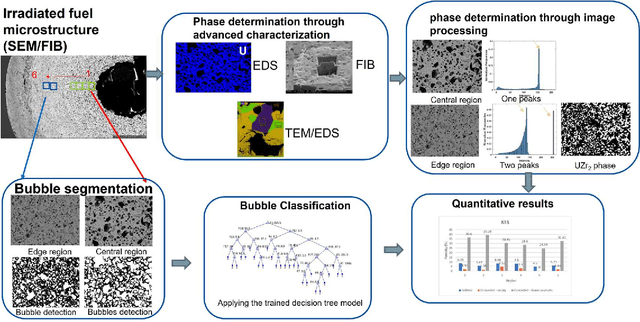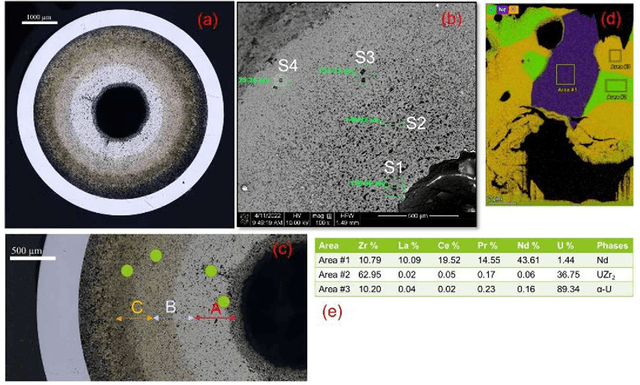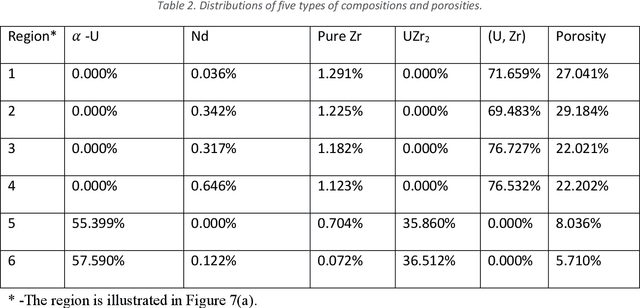Fidelma Dilemma
An Efficient Instance Segmentation Approach for Extracting Fission Gas Bubbles on U-10Zr Annular Fuel
Feb 08, 2023Abstract:U-10Zr-based nuclear fuel is pursued as a primary candidate for next-generation sodium-cooled fast reactors. However, more advanced characterization and analysis are needed to form a fundamental understating of the fuel performance, and make U-10Zr fuel qualify for commercial use. The movement of lanthanides across the fuel section from the hot fuel center to the cool cladding surface is one of the key factors to affect fuel performance. In the advanced annular U-10Zr fuel, the lanthanides present as fission gas bubbles. Due to a lack of annotated data, existing literature utilized a multiple-threshold method to separate the bubbles and calculate bubble statistics on an annular fuel. However, the multiple-threshold method cannot achieve robust performance on images with different qualities and contrasts, and cannot distinguish different bubbles. This paper proposes a hybrid framework for efficient bubble segmentation. We develop a bubble annotation tool and generate the first fission gas bubble dataset with more than 3000 bubbles from 24 images. A multi-task deep learning network integrating U-Net and ResNet is designed to accomplish instance-level bubble segmentation. Combining the segmentation results and image processing step achieves the best recall ratio of more than 90% with very limited annotated data. Our model shows outstanding improvement by comparing the previously proposed thresholding method. The proposed method has promising to generate a more accurate quantitative analysis of fission gas bubbles on U-10Zr annular fuels. The results will contribute to identifying the bubbles with lanthanides and finally build the relationship between the thermal gradation and lanthanides movements of U-10Zr annular fuels. Mover, the deep learning model is applicable to other similar material micro-structure segmentation tasks.
Advanced Characterization-Informed Framework and Quantitative Insight to Irradiated Annular U-10Zr Metallic Fuels
Oct 17, 2022



Abstract:U-10Zr-based metallic nuclear fuel is a promising fuel candidate for next-generation sodium-cooled fast reactors.The research experience of the Idaho National Laboratory for this type of fuel dates back to the 1960s. Idaho National Laboratory researchers have accumulated a considerable amount of experience and knowledge regarding fuel performance at the engineering scale. The limitation of advanced characterization and lack of proper data analysis tools prevented a mechanistic understanding of fuel microstructure evolution and properties degradation during irradiation. This paper proposed a new workflow, coupled with domain knowledge obtained by advanced post-irradiation examination methods, to provide unprecedented and quantified insights into the fission gas bubbles and pores, and lanthanide distribution in an annular fuel irradiated in the Advanced Test Reactor. In the study, researchers identify and confirm that the Zr-bearing secondary phases exist and generate the quantitative ratios of seven microstructures along the thermal gradient. Moreover, the distributions of fission gas bubbles on two samples of U-10Zr advanced fuels were quantitatively compared. Conclusive findings were obtained and allowed for evaluation of the lanthanide transportation through connected bubbles based on approximately 67,000 fission gas bubbles of the two advanced samples.
Understanding Fission Gas Bubble Distribution, Lanthanide Transportation, and Thermal Conductivity Degradation in Neutron-irradiated α-U Using Machine Learning
Apr 12, 2021



Abstract:UZr based metallic nuclear fuel is the leading candidate for next-generation sodium-cooled fast reactors in the United States. US research reactors have been using and testing this fuel type since the 1960s and accumulated considerable experience and knowledge about the fuel performance. However, most of knowledge remains empirical. The lack of mechanistic understanding of fuel performance is preventing the qualification of UZr fuel for commercial use. This paper proposes a data-driven approach, coupled with advanced post irradiation examination, powered by machine learning algorithms, to facilitate the development of such understandings by providing unpreceded quantified new insights into fission gas bubbles. Specifically, based on the advanced postirradiation examination data collected on a neutron-irradiated U-10Zr annular fuel, we developed a method to automatically detect, classify ~19,000 fission gas bubbles into different categories, and quantitatively link the data to lanthanide transpiration along the radial temperature gradient. The approach is versatile and can be modified to study different coupled irradiation effects, such as secondary phase redistribution and degradation of thermal conductivity, in irradiated nuclear fuel.
 Add to Chrome
Add to Chrome Add to Firefox
Add to Firefox Add to Edge
Add to Edge